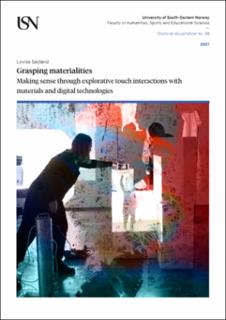| dc.contributor.author | Søyland, Lovise | |
| dc.date.accessioned | 2021-05-31T07:42:25Z | |
| dc.date.available | 2021-05-31T07:42:25Z | |
| dc.date.issued | 2021 | |
| dc.identifier.isbn | 978-82-7206-601-6 | |
| dc.identifier.issn | 2535-5252 | |
| dc.identifier.uri | https://hdl.handle.net/11250/2756969 | |
| dc.description.abstract | Our senses are deeply ingrained in the materiality of the world, and our embodied minds are shaped by touch interactions with the environment. Arts and crafts education is characterized by explorative, creative processes wherein children’s and adults’ tactile and haptic experiences are central to their interactions with various materials and technologies.
In recent years, there has been a digitalization of materiality in educational settings. This digitalization involves a change from using physical materials in early childhood education (ECE) and in early childhood teacher education (ECTE) to those based in the virtual realm. There has also been renewed interest in the connection between embodied action and cognition in recent years in studies documenting learning as an embodied process. However, few empirical studies on embodied cognition have been conducted to study the sensorial and explorative aspects of interaction with the materiality of digital technologies. The overall research question of this doctoral dissertation is: How can explorative touch interactions with physical and virtual materialities facilitate processes of sense-making? The conceptual framework of this dissertation is related to the theory of embodied cognition. The theory acknowledges that we develop knowledge and make sense through our embodied minds, which are rooted in the bodies’ sensory experience. This study applies an arts-based research (ABR) methodology in order to investigate haptic and tactile experiences. The study draws inspiration from sensory ethnography and a/r/tography and is supported by video documentation.
Through three case studies, sense-making in tactile and haptic interaction with physical and virtual materialities was studied. The case studies were explored using four sub-questions: What happens when we1 open up to experimental and unforeseen processes that transform physical and digital materials and phenomena into creative processes? How is touch interaction with a picturebook app facilitating or limiting sense-making? How do young children make sense of the world through explorative touch interactions with physical and virtual materialities? How do I make sense of a group of children’s and my own movements in physical and virtual environments through my a/r/tographic explorations? The first case involved ECTE students’ explorations in an arts and crafts teaching project. The study was conducted at the University of South-Eastern Norway. The students were invited to explore and experiment with different materials and technologies in a project room. The aim was to examine what happens in the manipulations of materiality throughout the creative process. The second case involved an in-depth explorative inquiry of my own touch interactions with a picturebook app. The app was selected because of its innovative use of virtual reality and facilitation of explorative interaction through touch. The third case examined children’s sense-making and exploration of physical and virtual materialities during a creative process. Similar to the first case, the children were invited to explore and interact with different materials and technologies in an arranged large-scale project room. The aim was to uncover how young children make sense of the world through explorative touch interactions with physical and virtual materialities.
During the study, six main themes were identified that have theoretical and practical implications for education. These themes are: (1) Tactile and haptic dimensions of materiality bridge understanding of the material to the virtual, (2) Emotions and imagination are embodied sense-making faculties during interaction with virtual materialities, (3) Virtual materiality can initiate new discoveries and shape the experience of the material world, (4) Digital technologies and strategies that provide opportunities for co-creation and exploration are essential to sensemaking, (5) Joint exploration influences the process of sense-making with digital technologies in interaction with the physical environment, (6) Haptic visuality and artistic forms of exploration can deepen understanding of sense-making and touch interaction. | en_US |
| dc.language.iso | eng | en_US |
| dc.publisher | University of South-Eastern Norway | en_US |
| dc.rights | Attribution-NonCommercial-NoDerivatives 4.0 Internasjonal | * |
| dc.rights.uri | http://creativecommons.org/licenses/by-nc-nd/4.0/deed.no | * |
| dc.subject | Sense-making | en_US |
| dc.subject | touch interaction | en_US |
| dc.subject | virtual materiality | en_US |
| dc.subject | haptic visuality | en_US |
| dc.subject | arts and crafts education | en_US |
| dc.subject | early childhood education | en_US |
| dc.subject | embodied cognition | en_US |
| dc.title | Grasping materialities: Making sense through explorative touch interactions with materials and digital technologies | en_US |
| dc.type | Doctoral thesis | en_US |
| dc.description.version | publishedVersion | en_US |
| dc.rights.holder | © The Author, except otherwise stated | en_US |
| dc.subject.nsi | VDP::Samfunnsvitenskap: 200::Pedagogiske fag: 280 | en_US |
| dc.source.pagenumber | 255 | en_US |

